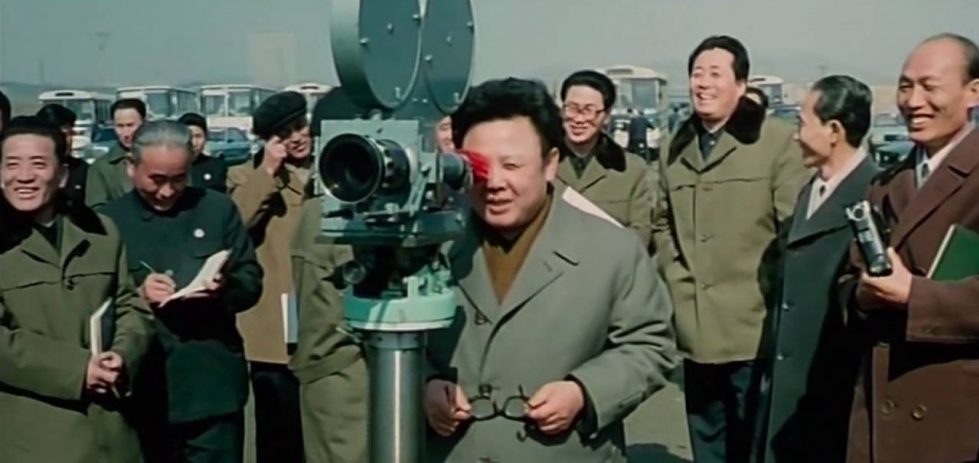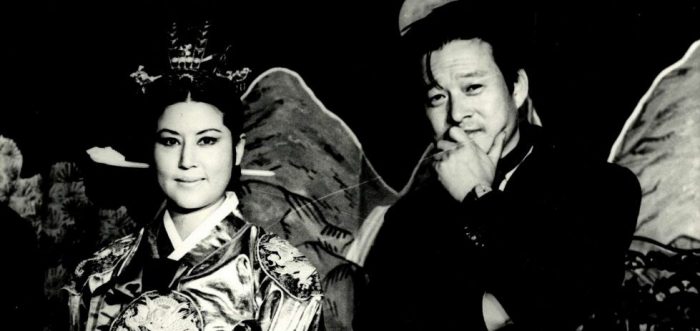
North Korea occupies an almost mythical space in the Western popular imagination: it’s a wellspring of narratives both bizarre and abhorrent, but always shrouded in mystery. The late Kim Jong-il, the nation’s supreme leader from 1994 until his death in 2011, appeared in the global media by turns as bogeyman and punchline.1 In The Lovers and the Despot, a documentary from Ross Adam and Robert Cannan, Kim is cast in a very different light: here he plays wannabe film producer and accidental matchmaker, who intervenes dramatically into the lives of two famous former lovers in the name of cinephilia.2
The story goes: acclaimed filmmaker Shin Sang-ok and movie star Choi Eun-hee were a South Korean celebrity power couple from the 1950s until the ‘70s, when Shin’s philandering lead to the break-up of the marriage. Shortly thereafter, Dear Leader Kim, apparently a big fan of their work, has the estranged pair abducted so that they might use their industry know-how to elevate North Korean cinema to new artistic heights. And they do—though not before being subjected to years of imprisonment and indoctrination.
You can’t make this stuff up… unless you’re Kim Jong-il, I guess. Shin and Choi’s experiences in North Korea are fascinating on both a human interest and political level; theirs is a remarkable love story, but also the source of special insight into a totalitarian regime, and the dictator formerly at its helm. The Lovers and the Despot proceeds carefully through the narrative by way of interviews with key players, supplemented by grainy re-enactments and thoughtfully repurposed clips from the many films on which Shin and Choi collaborated (alongside some incredible archival footage of North Korean spectacles). Choi is the film’s primary interviewee, whilst Shin, who passed away in 2006, is present in the form of audio recordings. So too is Kim himself, courtesy of illicit tapes made by the daring couple.
The recordings of Shin and Kim are haunting: close-ups of a whirring tape player accompany the audio, giving these sequences that eerie, true-crime feel (à la the chilling final scene of Errol Morris’s The Thin Blue Line). Hearing snippets of Kim’s private conversations evokes a strange sensation—it’s as if, like Dorothy in Oz, the viewer is being given a chance to glimpse the man behind the curtain; the one controlling all the smoke and mirrors. Shin’s comments also prove unsettling, because they blur the line between perpetrator and victim; freedom and captivity. He speaks of his inability to “betray” Kim: is this a symptom of Stockholm syndrome, or an admission that the diminutive dictator was not only his captor, but also perhaps his greatest benefactor?
Shin’s prestige as a filmmaker was in decline when he was abducted, his production company forcibly shut down and his directorial career floundering in the wake of increased censorship by the South Korean government. In North Korea, by contrast, once Shin was able to convince Kim of his loyalty, the pair were given the relative freedom of expression they had been denied in their home country, and the budgets to go with it. They were even allowed to travel, both to shoot overseas locales and attend film festivals. Their cage was to be a gilded one, so long as they cooperated.

Kim’s motivations in kidnapping Shin and Choi, and in supporting their work so enthusiastically, were twofold. For one, like his father before him, he understood the power of cinema, and he had been deeply involved in his country’s film industry since the ‘60s, through his role as the Minister for Propaganda. Little wonder an art form that trades on the magic of appearances was of such interest to a regime propped up by just that. Kim was also, however, a genuine cineaste and an avid viewer and collector of films from Hollywood and beyond, despite their complete unavailability to his citizens. He was part tyrant, part fanboy.
Kim’s kidnapping of South Korean film royalty seems to have been propelled more by a desire to make his nation’s cinema ‘great’ than ‘better at brainwashing people’: in one of the film’s particularly irony-laden moments, he bemoans the rigidly ideological tone of North Korean cinema.3 Consequently—remarkably—Shin and Choi were able to experiment and push North Korea’s cinematic envelope over the course of their captivity, using foreign locations and actors, toning down some of that heavy-handed rhetoric, and even injecting their movies with a modicum of escapism.
Although Adam and Cannan’s interviewees tells us of the pair’s access to these creative ‘freedoms’, we’re not given many opportunities to see how this actually manifested in their work. Given the quite exceptional conditions under which these films were made, and the inaccessibility of North Korean cinema to foreigners more generally, they seem like prime material for the purposes of this documentary.4 It;s disappointing that samples of films from Shin and Choi’s North Korean period—which was an incredibly productive one—are curiously thin on the ground, and critical assessment lacking.
Perhaps Adam and Cannan feared that a closer look at these films would somehow undercut the horror of their protagonists’ plight. This might also explain their seeming reluctance to embrace the sheer weirdness of the story—they’ve delivered a surprisingly po-faced treatment of a story riddled with improbable twists and turns. Although a more playful and inquisitive approach to some of the material would have been welcome, The Lovers and the Despot is undoubtedly a gripping and moving piece, its story of the bizarre love triangle between the dictator, the famous couple, and the cinema an astounding chapter in North Korean lore.
